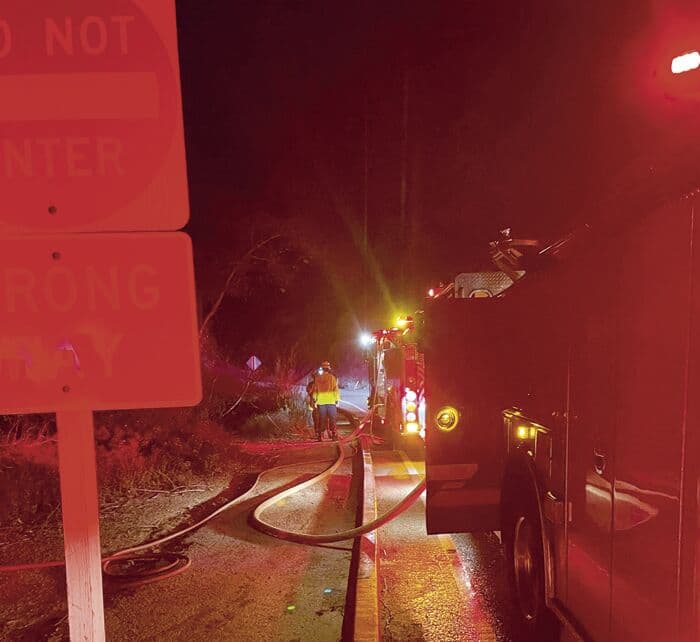
The Los Angeles County Fire Department responded to an emergency call about a fire at Tuna Canyon and Pacific Coast Highway on Sunday evening, Nov. 28. The department reported the fire was out within minutes.
“#LACoFD quickly extinguished a potentially dangerous brush fire in 7 minutes this evening at 9:35 p.m.,” according to a social media post posted later that night. “No injuries, no structures damaged, and the cause is under active investigation.”
The fire was reported during still conditions just two days after wind gusts were recorded up to 77 miles per hour elsewhere in the Santa Monica Mountains amid Red Flag conditions.
This was not the next “big one”–it was a small one, much to the relief of Big Rock residents. If it had happened 72 hours earlier when wind was whipping through Malibu and Southern California Edison had instituted its public safety power shut-off program, it may have caused a larger conflagration, with the issue compounded by a lack of electricity to power cell phones, emergency radios and even home phones, which now also do not work without electricity.
On Tuesday, Nov. 30, Malibu City Council held a special meeting to discuss options for emergency alert systems that do not depend on traditional means of communication that may be lost during fires and other emergencies such as earthquakes.
Options include both “indoor” and “outdoor” emergency warning systems, including tone alert radios, frequency modulation (FM) alerting, integrated public alert and warning system (IPAWS), NOAA weather radios using specific area message encoding (SAME) and national weather radio (NWR) transmission interrupt, plus outdoor air raid style sirens, each with its own pros and cons.
The FM alert program allows the city to use existing FM technology, although residents would need to buy new, special signaling devices. Similarly, NOAA would require residents to purchase or acquire special radios. IPAWS, which works on the same system that transmits Amber Alerts, did not seem to be a good solution for Malibu where cell service and power are usually lost in emergencies.
While some programs, such as NOAA radios, can target specific neighborhoods, the NWR program would send a sweeping message that could cause alarm or irritation to residents elsewhere in LA County.
What became clear on Tuesday was that none of these solutions would be implemented any time soon.
Beginning in July, members of the Malibu Public Safety Commission and local experts have formed an ad hoc committee to discuss which systems had the most benefits to alert locals about evacuations, power outages or emergency resources. Their conclusion, according to Public Safety Manager Susan Dueñas, is that it is still too soon to say.
“They thought that a lot of these systems have pros and cons [but] weren’t necessarily ready for employment in Malibu,” Dueñas described, adding that committee members believed “the city would be better off enhancing our current system.”
One committee member who came to speak, Public Safety Commission Vice Chair Doug Stewart, said the committee still had a ways to go before they could make a determination of what the best option would be.
“My test is at three o’clock in the morning, can we alert everybody and advise them what to do?” Stewart said. “The options that are on the table are broad–we’ve got 1950s technology with sirens, to current day technology with FM alert. So, it’s a broad range of options, there’s not going to be one solution that fits everything, but we are trying to find the best solution of all.”
Stewart added the committee was “nowhere close to making a recommendation to the council.”
Council Member Mikke Pierson said he knew of multiple residents in his Malibu West neighborhood who did not evacuate during the Woolsey Fire because they were not aware of evacuation orders. According to Pierson’s view, the best solution may be a combination.
“Would a siren have helped? I hope so,” Pierson said. “Would an indoor radio have helped? I hope so.”
Council approved the report but did not make any decisions, much to Mayor Pro Tem Bruce Silverstein’s chagrin.
“Waiting until the end of next year or even the year after? I don’t want to say it’s unacceptable, but it’s pretty close to unacceptable,” Silverstein said, later casting a “lukewarm yes” vote on approving the report without moving forward on any one system.